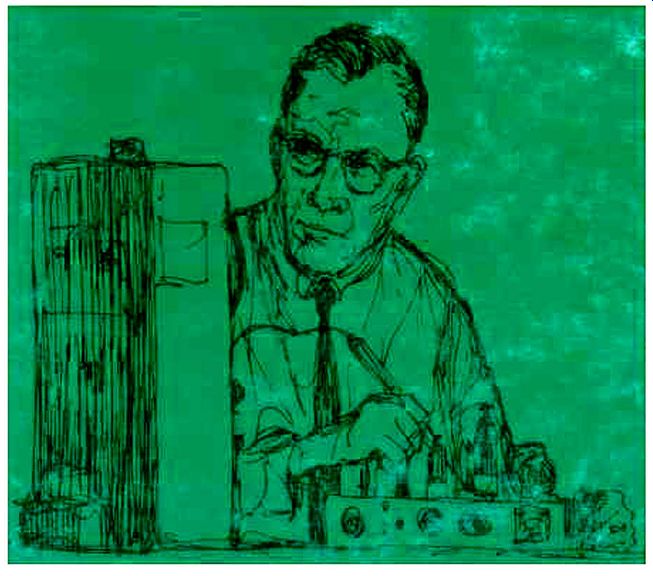AMAZON multi-meters discounts AMAZON oscilloscope discounts
Contents
Introduction (this page -- see below)
- Crystal demodulator probes: Classifications and advantages. Series and shunt detectors. Characteristics and requirements. Probe filter. Input voltage to probe. Probe input capacitance. Probe circuit time constants. Scope preamplifier. Grounding the probe. Interchangeability of probes.
- Working with crystal probes: Signal tracing. Waveforms. Undershoot. I.f. gain and alignment. Single stage response. Buzz. Testing video amplifiers. Crystal diode voltage and current ratings. Adjusting a video amplifier. Ratio-detector curve. Calibrating a marker generator. Sweep generator output. Grounds. Waveform errors. Maximum signal voltage.
- Voltage-doubler probes: Advantages. Voltage limitations. Peak-to-peak probe. Calibration of marker generator. Making ratio-detector S-curve. I.f. signal and sync buzz tracing. Color TV testing. Dead-stage indication, regeneration, sync buzz. Peak-to-peak voltage measurements. Frequency response. 60-cycle rejection.
- Balanced probes: Impedance matching. Need for balanced probe. Transmission line impedance. Zero-volt reference line. Testing transmission lines. Mis match between transmission line and antenna or TV input. Trans mission line losses. Construction of balanced probe. Gain and response of TV boosters. Balun.
- Low-capacitance probes: Circuit loading. Probe attenuation and design. Use of probe in high impedance, high-voltage circuits and in circuits with high d.c. component. Probe response vs. scope response. Scope calibration. Adjusting and extending voltage range. Tracing the TV sync signal. High-voltage adapter. Building a low-capacitance probe.
- High-voltage probes: Probe design and construction. How the probe works. Attenuation factor. Miscellaneous cables. Use with uncompensated scope. Behavior in 60-cycle circuits. 100-to-1 probe. Spotting flyback defects. Ripple in high-voltage supply. High-voltage buzz. Multiplication factor. Probe resistance. Safety precautions.
- Isolation and direct probes: Isolation probe for v.t.v.m. Reasons for using isolation probe. Probe construction. Effect of probe on meter calibration. Using the probe with a multitester. Using the isolation probe. Isolation probe for scope. Marker indication. The direct probe. Combined direct and isolation probe. Test leads.
- Specialized probes: Audio tracer. Capacitor-tester. Hum probe. Frequency-compensated probe. Probe amplifier. A.f. and r.f. tracer. Miniature test probes. R.f. indicator. R.f. voltmeter probe. Quadrupler probe. Magic-eye probe. Plugs and connectors. Neon-bulb probe. Probe housing. Cathode follower probe. Transistor probe.
- The Chromatic probe: Probe circuit. Development of a wide-band sweep. Single-image response. Using the Chromatic Probe. D.C. voltage at video amplifier input. Testing color TV. Demodulator probe limitations. Chromatic Probe maintenance. Chromatic Amplifier.
- Vacuum-tube probes: Transit time. Contact potential. High-frequency probe. Peak-to-peak probe. Cathode-follower probe. Using the cathode-follower probe. Grid-leak detector probe. Grid-dip probe. The grid-dip probe at work. Probe housing. Portable signal tracer. Signal tracer for AM, FM, and TV. Tube probe.
- Supplement--Television waveforms: Examining TV waveforms. Input to grid of horizontal amplifier. Pulses at plate of a.g.c. amplifier. Video i.f. waveforms. Output of V.H.F. tuner. Wave at input to horizontal deflection coil. Video amplifier waveshapes. TV wave in sync circuits. Wave at plate of vertical multivibrator.
Introduction
A probe is a link. It is a device connected between a test instrument (usually a scope or v.t.v.m.) and a radio or TV set being repaired. The simplest type of probe can be nothing more than just a pair of test leads. Alternatively, it can be complicated to the extent that a complete detecting and amplifying system will be inside the probe housing. Although most probes are characterized by the use of few components and elementary circuit structure, yet the work they must perform is out of all proportion to their size. Because a piece of test equipment, such as a probe, is small or inexpensive, does not mean that it is unimportant or unnecessary. The finest v.t.v.m. or scope is limited by the kind of probe you use with such equipment and by your own knowledge of probes.
Regardless of the particular probe you use at any time, a probe has one job and one job only. A probe is supposed to bring the voltage or waveshape being measured or examined out of the receiver and into the test instrument. In effect, what you are doing is getting the voltage or waveshape that interests you out of the defective receiver and into the open where it can be more easily inspected.
There are a few requirements that are imposed on the probe.
It must not load the circuit being checked. It should not reduce the voltage at the point under test. A probe can be used to measure a voltage, in which case the voltage must remain the same at the point being tested, with or without the probe connection.
If a probe is used for waveshape analysis, it must pick up that waveshape and transfer it to your scope without making any change in the shape of that wave. And finally, since probes are used for making dynamic tests (that is, with the radio or TV set turned on and working) the probe must do nothing to disturb the set.
The number of probes you will need for your servicing work will depend entirely upon you. Obviously, the ideal arrangement is to have a probe for each specific function. Although probes are comparatively inexpensive you can build your own if you wish, buy individual probes as you need them or else get a complete probe set. Again this is a matter for personal choice.
More than almost any kind of project, a technical book is a cooperative enterprise. Many persons and organizations were kind enough and gracious enough to make this publication a possibility. We acknowledge with thanks, assistance from these well-known companies: Admiral Corp.; Allen B. Du Mont Laboratories, Inc.; Browning Laboratories; Cornell-Dubilier Electric Corp.; Electronic Instrument Co., Inc.; Electronic Measurements Corp.; General Electric Co., Hickok Electrical Instrument Co., Jackson Electrical Instrument Co.; Linear Equipment Laboratories, Inc.; Magnavox Co.; National Bureau of Standards; Precise Development Corp.; Precision Apparatus Company, Inc.; Pres Probe Co.; Radio Corp. of America; RADIO-ELECTRONICS Magazine, Scala Radio Co.; Simpson Electric Co.; Supreme, Inc.; Sylvania Electric Products, Inc.; Tektronix, Inc.

(Note: This guide based on the 1955 book)
Also see: Industrial Electronics (in the early 1960s)